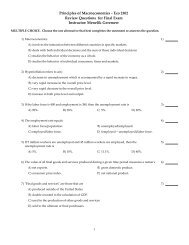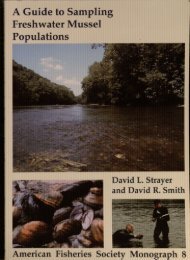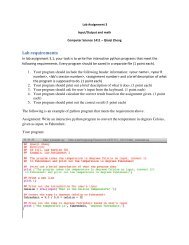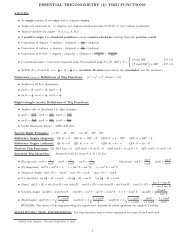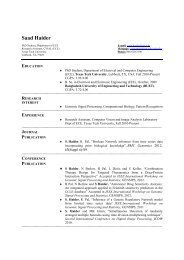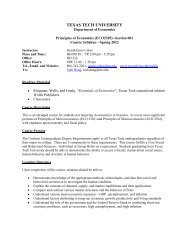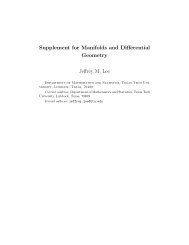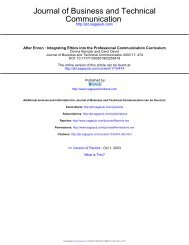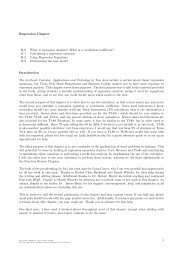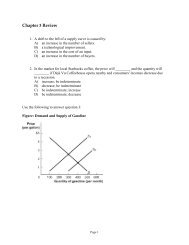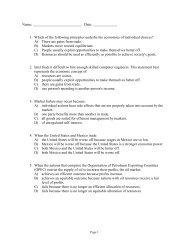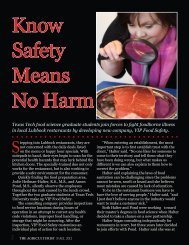Download - MyWeb - Texas Tech University
Download - MyWeb - Texas Tech University
Download - MyWeb - Texas Tech University
You also want an ePaper? Increase the reach of your titles
YUMPU automatically turns print PDFs into web optimized ePapers that Google loves.
The 2012 Season of the Chan Chich Archaeological Project<br />
of the creek in his report as a succession of<br />
pools in the dry season and the fact that his<br />
map does not show the creek connecting to<br />
the Rio Bravo suggest that he only crossed the<br />
creek southwest of the ruins of Chan Chich,<br />
certainly along the border between Guatemala<br />
and British Honduras, but possibly along the<br />
road between Kaxil Uinic and San Jose.<br />
To return to the issue at hand, Kaxil Uinic<br />
village, Teobert Maler (1910:151) makes<br />
two mentions of “Kaxilvinic” on his journey<br />
from Merida in Yucatan to Lake Peten-Itza<br />
in Guatemala. Departing the small village of<br />
Chúnkutil, Mexico on May 9, 1895, Maler<br />
(1910:151) reported:<br />
The second day’s march brought us<br />
to the wholly abandoned settlement<br />
of Santa Rita…From this Santa Rita<br />
a path branches to the left, to the east,<br />
toward Kaxilvinic, three days’ journey<br />
distant, and Icaiché, the dread retreat<br />
of the free Mayas, is two days distant<br />
from Kaxilvinic. Today this path is<br />
untraveled and wholly overgrown.<br />
Icaiche was a settlement in southern Quintana<br />
Roo, infamous for harassing the British in<br />
northern Belize in the nineteenth century<br />
(Bolland 1977). The Maya living at Kaxil<br />
Uinic were a splinter group that had migrated<br />
from the Chichanha region of Mexico into the<br />
area following the Caste War in 1857 (Jones<br />
1977). This group, which moved into an<br />
unoccupied region of Belize and Guatemala,<br />
became known as the San Pedro Maya, named<br />
after the principal village south of Labouring<br />
Creek (Jones 1977:141). Jones (1977:157,<br />
162) reports that Kaxil Uinic was settled in<br />
the 1880s as the third village in what he calls<br />
the San José Minor Cluster, speculating that<br />
migrants from a Holmul cluster village named<br />
Holuitz that was abandoned sometime after<br />
1868 may have originally settled Kaxil Uinic<br />
village. Jones also (1977:161–162) provides<br />
the most detailed account of the settlement in<br />
the literature:<br />
Kaxiluinic was on the Río Bravo,<br />
about 19 kilometers west-northwest<br />
of San José and about 5 kilometers<br />
from the western boundary line. It<br />
does not appear in the historical record<br />
until January 1885, when Mexicans<br />
were said to have escaped through<br />
the settlement following some grisly<br />
murders committed by them at a<br />
mahogany bank near San José. Later<br />
that year a British party under William<br />
Miller began to resurvey the western<br />
boundary line and ran into difficulty<br />
with the inhabitants of Kaxiluinic, who<br />
apparently considered themselves to<br />
be on Mexican territory. Gov. Roger<br />
Tucksfield Goldsworthy asked Gen.<br />
Gabriel Tamay of Icaiche to order the<br />
alcalde of Kaxiluinic, one Antonio<br />
Baños, to put a stop to the disturbances.<br />
Tamay, however, had already denied<br />
knowledge of the settlement. Tamay’s<br />
denial was false, for in July there were<br />
further “disquieting rumours from<br />
the village of Kaxi Venic regarding<br />
the attitude of the Indians of Ycaiche<br />
towards the Survey Party,” and the<br />
survey party later crossed “an old trail<br />
that was supposed to be lead from Xaxe-<br />
Venic to Ycaiche.” Miller’s map of<br />
the Western frontier shows Kaxiluinic<br />
connected with both Icaiche and San<br />
José by this path.<br />
The intersection of the discussions about Kaxil<br />
Uinic village and Kaxil Uinic ruins come in the<br />
form of Sir J. Eric S. Thompson (1963), who<br />
planned to excavate the ruins using labor from<br />
the village in 1931. Thompson mentioned that<br />
“There is a Maya village at Kaxwinik, where<br />
it should be easy to obtain labor, thus avoiding<br />
the expense of importing labor and the laborers’<br />
food, the transportation of which during the<br />
34



